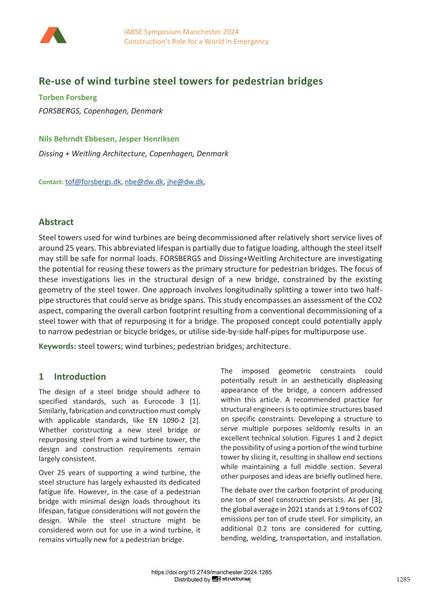Re-use of wind turbine steel towers for pedestrian bridges

|
|
|||||||||||
Bibliografische Angaben
| Autor(en): |
Torben Forsberg
(FORSBERGS, Copenhagen, Denmark)
Nils Behrndt Ebbesen (Dissing + Weitling Architecture, Copenhagen, Denmark) Jesper Henriksen (Dissing + Weitling Architecture, Copenhagen, Denmark) |
||||
|---|---|---|---|---|---|
| Medium: | Tagungsbeitrag | ||||
| Sprache(n): | Englisch | ||||
| Tagung: | IABSE Symposium: Construction’s Role for a World in Emergency, Manchester, United Kingdom, 10-14 April 2024 | ||||
| Veröffentlicht in: | IABSE Symposium Manchester 2024 | ||||
|
|||||
| Seite(n): | 1285-1294 | ||||
| Anzahl der Seiten (im PDF): | 10 | ||||
| DOI: | 10.2749/manchester.2024.1285 | ||||
| Abstrakt: |
Steel towers used for wind turbines are being decommissioned after relatively short service lives of around 25 years. This abbreviated lifespan is partially due to fatigue loading, although the steel itself may still be safe for normal loads. FORSBERGS and Dissing+Weitling Architecture are investigating the potential for reusing these towers as the primary structure for pedestrian bridges. The focus of these investigations lies in the structural design of a new bridge, constrained by the existing geometry of the steel tower. One approach involves longitudinally splitting a tower into two half- pipe structures that could serve as bridge spans. This study encompasses an assessment of the CO₂ aspect, comparing the overall carbon footprint resulting from a conventional decommissioning of a steel tower with that of repurposing it for a bridge. The proposed concept could potentially apply to narrow pedestrian or bicycle bridges, or utilise side-by-side half-pipes for multipurpose use. |
||||
| Stichwörter: |
Architektur Fußgängerbrücken Windkraftanlagen
|
||||

